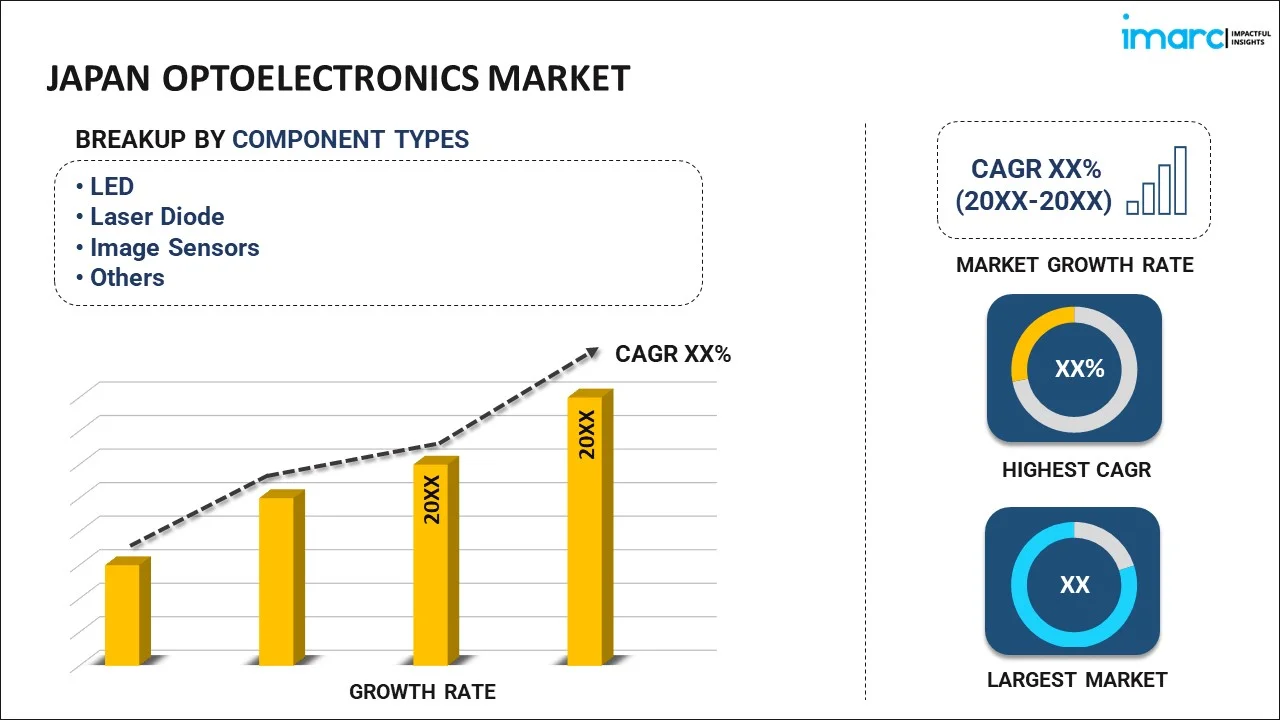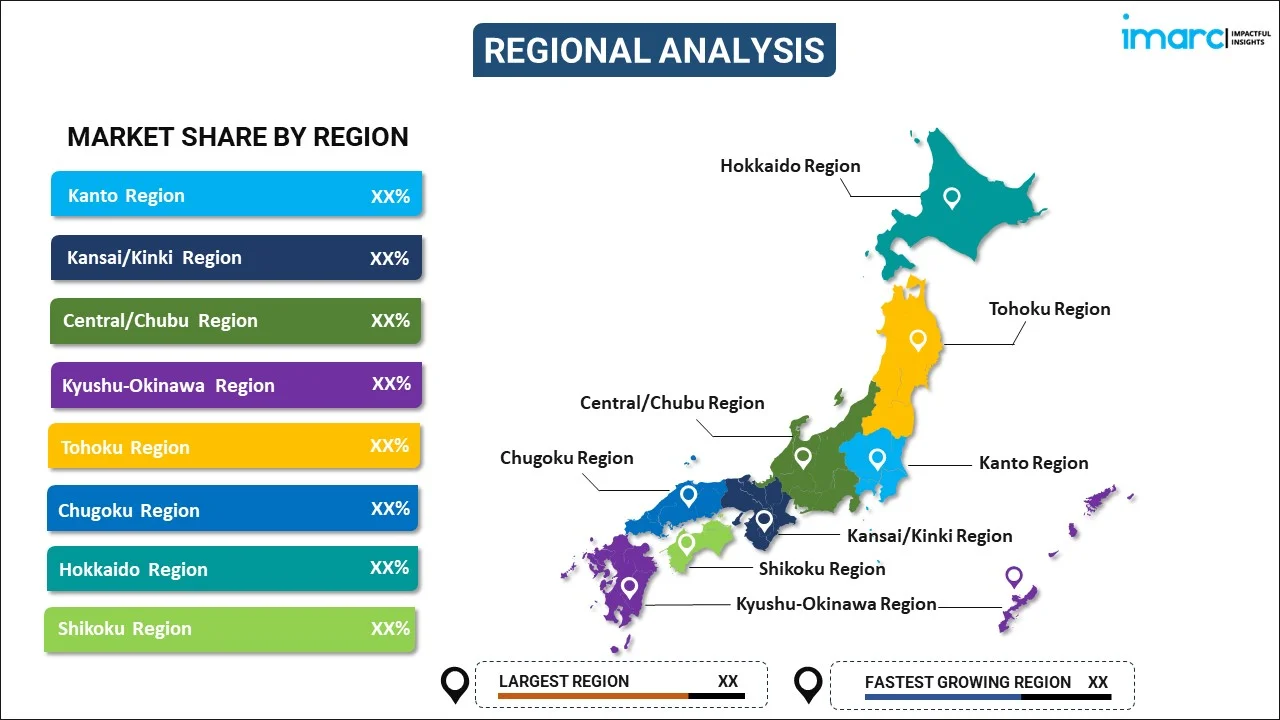
Japan Optoelectronics Market Report by Component Type (LED, Laser Diode, Image Sensors, Optocouplers, Photovoltaic Cells, and Others), End Use Industry (Automotive, Aerospace and Defense, Consumer Electronics, Information Technology, Healthcare, Residential and Commercial, Industrial, and Others), and Region 2025-2033
Market Overview:
Japan optoelectronics market size reached USD 2,554 Million in 2024. Looking forward, IMARC Group expects the market to reach USD 5,422 Million by 2033, exhibiting a growth rate (CAGR) of 8.7% during 2025-2033. The expanding telecommunications industry, along with the growing need for high-speed communication solutions, is primarily driving the market growth.
|
Report Attribute
|
Key Statistics
|
|---|---|
|
Base Year
|
2024
|
|
Forecast Years
|
2025-2033
|
|
Historical Years
|
2019-2024
|
|
Market Size in 2024
|
USD 2,554 Million |
|
Market Forecast in 2033
|
USD 5,422 Million |
| Market Growth Rate 2025-2033 | 8.7% |
Optoelectronics is a dynamic branch of electronics that intertwines the principles of both optics and electronics. This interdisciplinary field primarily focuses on the study, design, and application of electronic devices that source, detect, and control light. These devices can operate in the visible, ultraviolet, or infrared segments of the electromagnetic spectrum. Optoelectronics has become a cornerstone for several advanced technological applications, from fiber-optic communication systems that transmit vast amounts of data over long distances to sensors in everyday electronics like smartphones and cameras. As our world becomes more interconnected and reliant on rapid communication, the significance of optoelectronics in modern technology continues to surge. Furthermore, with advancements in materials science, especially in the realm of semiconductors, optoelectronic devices are becoming more efficient, compact, and versatile.
Japan Optoelectronics Market Trends:
The Japan optoelectronics market is characterized by several innovations and a deep-rooted commitment to technological advancement. One of the most prominent drivers is the surge in demand for high-speed communication and data transfer solutions. With the proliferation of 5G and the Internet of Things (IoT) devices, the necessity for advanced optoelectronic components, particularly in fiber-optic communication systems, has increased. This is complemented by Japan's optimal telecommunication infrastructures and its aim to be at the forefront of the digital revolution. Another trend gaining traction is the rising application of optoelectronic sensors in automotive and robotics sectors. As Japan steers towards autonomous vehicles and smart manufacturing, the demand for precision sensors, which rely on optoelectronic principles, has surged. Furthermore, the consumer electronics segment, including smartphones, smart TVs, and wearables, all of which Japan excels in producing, integrates a myriad of optoelectronic components, from display modules to advanced cameras. Investments in R&D activities remains robust, with both government and private sectors keen on maintaining Japan's competitive edge. The synergy of policy support, industry expertise, and market demand has cemented Japan's position as a key player in the optoelectronics domain, with prospects for further growth and innovation on the horizon. These factors will continue to propel the regional market in the coming years.
Japan Optoelectronics Market Segmentation:
IMARC Group provides an analysis of the key trends in each segment of the market, along with forecasts at the country level for 2025-2033. Our report has categorized the market based on component type and end use industry.
Component Type Insights:

- LED
- Laser Diode
- Image Sensors
- Optocouplers
- Photovoltaic Cells
- Others
The report has provided a detailed breakup and analysis of the market based on the component type. This includes LED, laser diode, image sensors, optocouplers, photovoltaic cells, and others.
End Use Industry Insights:
- Automotive
- Aerospace and Defense
- Consumer Electronics
- Information Technology
- Healthcare
- Residential and Commercial
- Industrial
- Others
A detailed breakup and analysis of the market based on the end use industry have also been provided in the report. This includes automotive, aerospace and defense, consumer electronics, information technology, healthcare, residential and commercial, industrial, and others.
Regional Insights:

- Kanto Region
- Kansai/Kinki Region
- Central/ Chubu Region
- Kyushu-Okinawa Region
- Tohoku Region
- Chugoku Region
- Hokkaido Region
- Shikoku Region
The report has also provided a comprehensive analysis of all the major regional markets, which include Kanto Region, Kansai/Kinki Region, Central/ Chubu Region, Kyushu-Okinawa Region, Tohoku Region, Chugoku Region, Hokkaido Region, and Shikoku Region.
Competitive Landscape:
The market research report has also provided a comprehensive analysis of the competitive landscape. Competitive analysis such as market structure, key player positioning, top winning strategies, competitive dashboard, and company evaluation quadrant has been covered in the report. Also, detailed profiles of all major companies have been provided.
Japan Optoelectronics Market Report Coverage:
| Report Features | Details |
|---|---|
| Base Year of the Analysis | 2024 |
| Historical Period | 2019-2024 |
| Forecast Period | 2025-2033 |
| Units | Million USD |
| Scope of the Report | Exploration of Historical Trends and Market Outlook, Industry Catalysts and Challenges, Segment-Wise Historical and Future Market Assessment:
|
| Component Types Covered | LED, Laser Diode, Image Sensors, Optocouplers, Photovoltaic Cells, Others |
| End Use Industries Covered | Automotive, Aerospace and Defense, Consumer Electronics, Information Technology, Healthcare, Residential and Commercial, Industrial, Others |
| Regions Covered | Kanto Region, Kansai/Kinki Region, Central/ Chubu Region, Kyushu-Okinawa Region, Tohoku Region, Chugoku Region, Hokkaido Region, Shikoku Region |
| Customization Scope | 10% Free Customization |
| Post-Sale Analyst Support | 10-12 Weeks |
| Delivery Format | PDF and Excel through Email (We can also provide the editable version of the report in PPT/Word format on special request) |
Key Questions Answered in This Report:
- How has the Japan optoelectronics market performed so far and how will it perform in the coming years?
- What has been the impact of COVID-19 on the Japan optoelectronics market?
- What is the breakup of the Japan optoelectronics market on the basis of component type?
- What is the breakup of the Japan optoelectronics market on the basis of end use industry?
- What are the various stages in the value chain of the Japan optoelectronics market?
- What are the key driving factors and challenges in the Japan optoelectronics?
- What is the structure of the Japan optoelectronics market and who are the key players?
- What is the degree of competition in the Japan optoelectronics market?
Key Benefits for Stakeholders:
- IMARC’s industry report offers a comprehensive quantitative analysis of various market segments, historical and current market trends, market forecasts, and dynamics of the Japan optoelectronics market from 2019-2033.
- The research report provides the latest information on the market drivers, challenges, and opportunities in the Japan optoelectronics market.
- Porter's five forces analysis assist stakeholders in assessing the impact of new entrants, competitive rivalry, supplier power, buyer power, and the threat of substitution. It helps stakeholders to analyze the level of competition within the Japan optoelectronics industry and its attractiveness.
- Competitive landscape allows stakeholders to understand their competitive environment and provides an insight into the current positions of key players in the market.
Need more help?
- Speak to our experienced analysts for insights on the current market scenarios.
- Include additional segments and countries to customize the report as per your requirement.
- Gain an unparalleled competitive advantage in your domain by understanding how to utilize the report and positively impacting your operations and revenue.
- For further assistance, please connect with our analysts.
 Inquire Before Buying
Inquire Before Buying
 Speak to an Analyst
Speak to an Analyst
 Request Brochure
Request Brochure
 Request Customization
Request Customization




.webp)




.webp)












